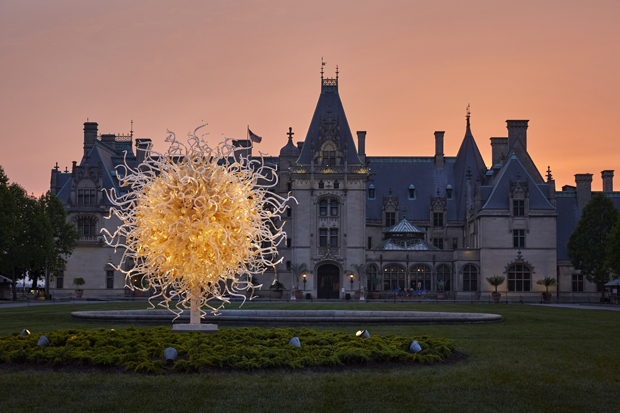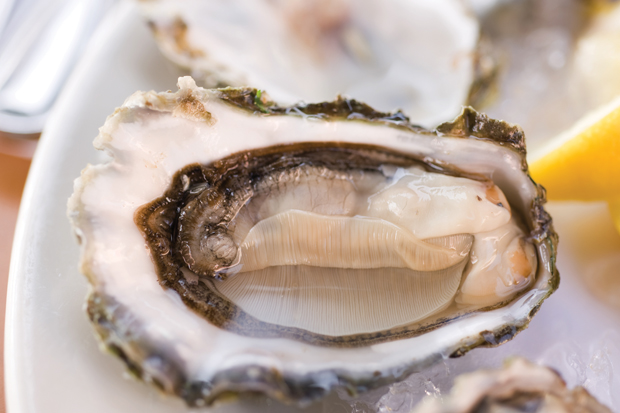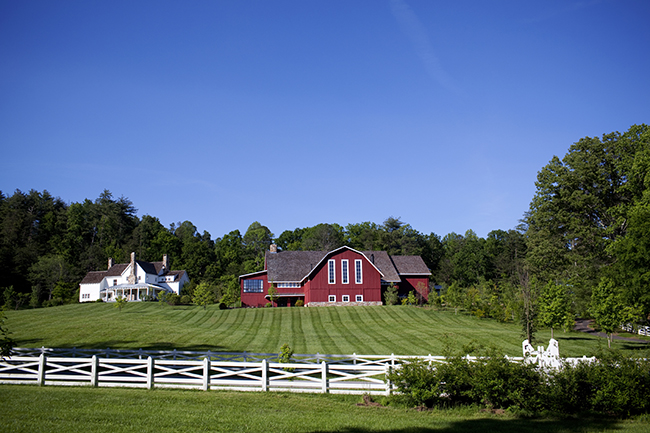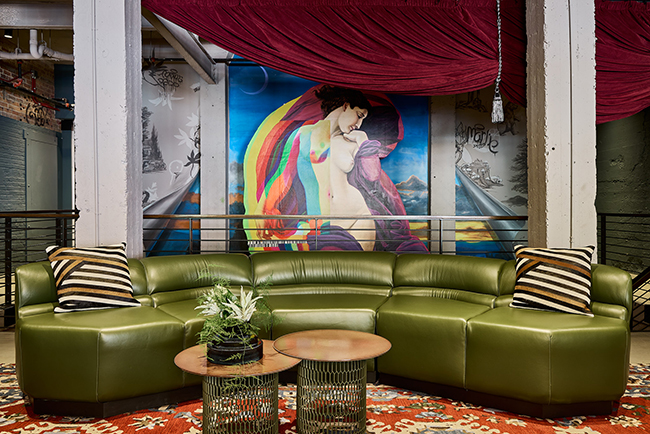The Biltmore Gardens
09 Sep 2018
Renowned glass sculpturist Dale Chihuly excites the landscape at Biltmore House
By Katie McElveen

With its French-inspired architecture and classic garden design, Asheville’s Biltmore House seems, at first glance, like an unlikely spot to host an exhibition of Dale Chihuly’s stunningly contemporary glass sculptures. But dig a little deeper, and the synergy begins to emerge, making Chihuly at Biltmore not just beautiful to behold, but perfectly relevant to the locale.
One reason is that while Biltmore House has a traditional exterior that was inspired by a trio of chateaux located in France’s Loire Valley, George Vanderbilt prized innovation, filling the home with then-futuristic systems such as central heating and plumbing, electricity, mechanical refrigeration, fire alarms and elevators. Then there’s landscape architect Frederick Law Olmstead, who rigorously designed every inch of his spaces with the goal of creating a beautiful scene meant to be enjoyed from any angle. Add to that Chihuly’s gift for creating installations in response to their surroundings—and the experience takes on an entirely different perspective.
It takes about 10 minutes to drive from the entrance of the Biltmore Estate to the home; along the way, the roadway meanders past quiet ponds, deep forests and horse-filled pastures. Wanting to park closer to the garden than the home, I bypassed the signs to the main lots, curved through more shady green space and found myself within the walled park that comprises the home’s front yard. It was here that I got my first glimpse of Chihuly’s work, in this case, a 14-foot tall golden orb composed of 14,000 clear, amber and golden horns, corkscrews and curlicues presiding over the endless green lawn. I couldn’t wait to park the car and walk back over to take a closer look.
But then I got distracted, first by the summer plantings, then by the rest of the exhibition, which, for me, began in the conservatory, where three iconic chandeliers float like ethereal sea creatures over lush palms, stately orchids and jungly vines. Since there’s no signage to direct your gaze upward, the installation is easy to miss, particularly when it’s so easy to be completely taken by masses of plants so perfect they look artificial. Created in soft shades of teal, amber and citron, the chandeliers are newly composed for Biltmore from about 1,000 pieces of blown glass. Bill Quade, Biltmore’s lead horticulturist on the Chihuly project, tells me that while the glass pieces look delicate, they’re actually quite sturdy, able to take more than a little stress. Still, the team uses a feather duster to keep them clean.
Where the chandeliers are ornate and softly colored, the vermillion-hued reeds that make up the “Cattails and Copper Birch Reeds” installation just outside the conservatory are bold and sleek. It takes two glassblowers to create each reed, one elevated on a mechanical lift, which encourages the form to stretch; the other on the ground pulling the molten glass downward. Like most of Chihuly’s smooth pieces, the reeds, on closer inspection, are more intricate than they seem, containing layers of glass that allow the colors to vary as the angle of the sun changes throughout the day.
As we strolled up the steps toward the walled garden’s two dramatic towers, Quade notes that he and his team worked closely with the Chihuly staff for about a year and a half to determine how the gardens would be planted to best highlight the 16 installations. “We sent drawings back and forth until the colors, textures and layers of the “plant palette” had been chosen,” he explains. It was then up to the Biltmore horticulturists to find the plants that would bring the palette to life. As an example, Quade steps lightly into the bed of green-leaf begonias that surround “Electric Yellow and Deep Coral Tower,” plucks a single flower and holds it against the smooth red glass. “We went for drama and color for this installation and chose this variety of begonia because the red flower perfectly matches the color of the glass,” he says. “The Black-Eyed Susans in the next layer pick up the yellow but contrast with the red.”
The team took a different tack with “Red Reeds”, which juxtaposes tall, graceful scarlet reeds against a lush backdrop of greenery—azaleas, hydrangeas, spirea, forsythia and others—in a variety of textures and heights. The landscape is a first for “Red Reeds”, which is usually set on grass. “It’s gorgeous, especially at night, because the reeds seem to levitate and the tips glow blue,” says Quade. “This show marks the first time that Biltmore’s gardens have been open to public at night. In addition to planning each installation, we had to wire the garden for electricity and figure out where to put the outlets!”
As we headed toward the Italian Garden, it was hard not to pause under the vine-draped pergola to take in “Pergola Garden Fiori,” the series of colorful, sea-themed sculptures set along a narrow walkway. The only installation that doesn’t offer a 360-degree view, “Pergola Garden Fiori” is also one of the most dramatic, a display of glass figures that seem to move as if they’re dancing with an unseen ocean current. Set against the unrelenting stillness of the wall, the spirited forms seemed gleeful to be occupying that very space. I suddenly understood Chihuly’s magic.
Most visitors to Biltmore Estate see the Italian Garden’s five installations early in their tour; we saw it near the end and I’m glad we did. Bright as a kaleidoscope, whimsical as a fairy tale and filled with layers of detail, the series invites a long stay. There are giant glass spheres to examine, fish to watch, a boat to ponder and, of course, photo after photo to snap in search of a single frame that will capture it all. I would hate to have felt rushed to move on to the next garden gallery.
Only one installation is set within Biltmore House. Created in shades of gold, white, champagne and sienna, “Laguna Torcello II” is a gilded ode to Venice, one of Chihuly’s favorite cities. The work is like a treasure chest: hidden within the twisty horns I discovered a variety of sea life, including shells, ampules and figures. Set under a dome of windows, it did, in fact, seem as if it was under the ocean. Like each piece in this captivating show, it was somehow transporting and grounding all at the same time. Had there been a bench, I would have been quite happy to spend the rest of the afternoon gazing at the work, waiting for it to come to life.
If you go…
There was a time when a visit to Biltmore House was just that—a house tour, a stroll through the gardens and a quick trip through the gift shop. Today, though, the 8,000 acre estate is open to guests and can be explored by bike, on horseback or horse-drawn carriage and even on a Segway via 22 miles of trails. The estate is open to all ticketholders, but the best way to take it in (and take advantage of fun activities like falconry, kayaking and fly-fishing) is to spend a night (or two) at one of the estate’s on-site hotels. The plush Inn on Biltmore Estate offers gorgeous mountain views and a full-service spa; the family-friendly Village Hotel is located next to the shops and restaurants of Antler Hill Village and Winery. Not only will a longer stay take the pressure off of exploring in the entire 175,000 square-foot house and Chihuly exhibit in one day, but it will give you time to enjoy the remarkable grounds. Both resorts offer packages that include activities, admission to Biltmore House and other discounts.
Chihuly at Biltmore runs through October 7, 2018. Admission is included in a daily pass to Biltmore Estate; a separate ticket is required to view the show in the evening.














